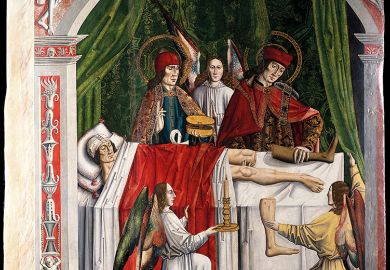The legend of King Arthur has a tight hold on the British imagination – to the extent that our National Lottery operator is named after his court, and that barely a year passes without someone claiming to have discovered the true location of Camelot. The heroic monarch has also inspired huge numbers of books, to which Nicholas Higham has now added.
Fortunately, King Arthur is vastly superior to most writing on this topic, although (as its subtitle hints) it will certainly be a disappointment to anyone hoping for new information about the real Arthur. Rather than a history of King Arthur (whose existence is firmly denied), this is an examination of the many stories that have been told about him, and of the reasons for the potency of this legend.
The first half of the book focuses on the possibility of a “foreign” Arthur, examining theories that he may have been a Roman soldier from Dalmatia, or a figure developed from Greek or Eurasian mythology. Each possibility is explored in considerable depth, only to be disproved; the evidence for each, it is convincingly argued, is at best flimsy. The disposal of weapons in water, for example, was a widespread practice in the pre-modern world, and thus there is no good reason to suppose that Arthur’s insistence that Excalibur be thrown into the lake was inspired by a similar tale about the hero Batraz in the Caucasian Nart sagas. Indeed, much of the evidence here is so weak that it perhaps deserves less detailed consideration than it is given.
The second section, which focuses on the “British” Arthur, is rather more compelling. Dismissing the possibility that Arthur began life as a Celtic god, or even as part of a bear cult, Higham takes the reader through the various texts that have been used to prove the king’s existence. For several centuries, there is nothing but silence: the 6th-century writer Gildas, for example, had nothing to say on the subject, an omission that Higham (surely correctly) deems significant.
Then, in the early 9th century, an “imaginative clerk” named Nennius wrote a Historia Brittonum (History of the Britons), in which Arthur (at this point a mere general) is credited with 12 decisive victories. From this single (politically motivated and dubiously sourced) text, the legend grew.
After this, Arthur’s existence was taken as fact, and his reputation was much enhanced by Geoffrey of Monmouth’s Historia Regum Britanniae (History of the Kings of Britain), which transformed him into the king of legend. Subsequent medieval authors embroidered the story further, inventing Camelot, the Holy Grail and the Round Table. Cynicism grew, and interest declined, during the early modern period. But, since the 19th century, interest in Arthur has grown again, and with it a new band of devotees dedicated to uncovering the truth about the “Once and Future King”.
By demonstrating how little we know about Arthur, Higham reveals the key to his appeal: he is so elusive a figure that he can be whatever we want him to be. The history of the Arthurian legend is, in many ways, a history of the worldviews and purposes of those who created it. Arthur will surely continue to evolve with us.
Katherine Harvey is a research fellow in medieval history at Birkbeck, University of London working on a book about medieval episcopal bodies.
King Arthur: The Making of the Legend
By Nicholas J. Higham
Yale University Press, 392pp, £25.00
ISBN 9780300210927
Published 16 October 2018
POSTSCRIPT:
Print headline: The man, the myth, the legend
Register to continue
Why register?
- Registration is free and only takes a moment
- Once registered, you can read 3 articles a month
- Sign up for our newsletter
Subscribe
Or subscribe for unlimited access to:
- Unlimited access to news, views, insights & reviews
- Digital editions
- Digital access to THE’s university and college rankings analysis
Already registered or a current subscriber?







